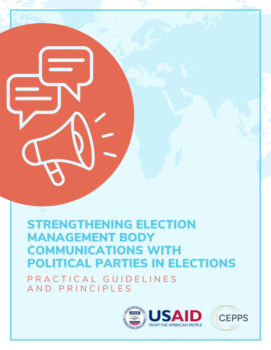High levels of political polarization globally have made election administration work even more delicate. Mistrust between political parties and candidates often spills over to election management bodies (EMBs) whose work might be called into question even when election authorities are doing their best to deliver independent and fair processes. While it is impossible to completely shield EMBs from these suspicions, developing more proactive communication strategies tailored to political parties and candidates can help assuage them and build the trust that is crucial to acceptance of election results.
 It was with this goal in mind that CEPPS developed the “Strengthening Election Management Body Communications with Political Parties in Elections” guide. This new resource identifies factors that shape how EMBs engage and communicate with parties and highlights common mechanisms used by these institutions around the world – and the extent to which they meet established principles in communication and stakeholder engagement. Furthermore, the guide provides practical resources to help EMBs optimize their existing communication channels or create new ones that best fit their needs. The step-by-step instructions, below, draw on the guide’s findings and insights.
It was with this goal in mind that CEPPS developed the “Strengthening Election Management Body Communications with Political Parties in Elections” guide. This new resource identifies factors that shape how EMBs engage and communicate with parties and highlights common mechanisms used by these institutions around the world – and the extent to which they meet established principles in communication and stakeholder engagement. Furthermore, the guide provides practical resources to help EMBs optimize their existing communication channels or create new ones that best fit their needs. The step-by-step instructions, below, draw on the guide’s findings and insights.

How can EMBs take their communication with political parties and candidates to a higher level?
Step 1. Take stock of factors shaping EMB engagement with political parties
EMBs operate in very different environments. Their compositions, mandates and legal requirements, oversight responsibilities, and budgets vary significantly, and all these factors can impact their ability to engage with political parties. In addition to these internal issues, the political party landscape, including how many exist and their willingness to engage with EMBs, can also be very different. The guide offers a Baseline Assessment framework with a series of guiding questions to help EMBs map all these factors and better identify weaknesses and opportunities for engagement.
Step 2. Identify clear goals
Although “effective communications” may seem like a straightforward goal, the contexts in which EMBs are operating might offer helpful nuances to make objectives more achievable. Are there gaps in political parties’ understanding about the electoral process? Is there a need to improve political party compliance with regulations? Or is the main goal to reduce distrust about EMB’s impartiality? Clearly delineating these goals is an essential step, especially when resources are scarce and EMBs need to prioritize in which initiatives to invest.
Step 3. Map existing communication mechanisms
Once goals are delineated, EMBs should engage in a thorough exercise to map its existing communication mechanisms, analyze the extent to which they meet effective communication principles, understand how they may contribute to achieving goals, and what is keeping them from fully doing so. This is also a good time to ponder whether existing mechanisms are enough or new channels or strategies might be necessary.
Step 4. Consider the budget
As improvements to existing mechanisms or the development of new ones are considered, EMBs must take a careful look at their budgets and keep sustainability as a top priority. Can the institution afford to hire appropriate personnel, conduct specific training, or cover the costs of new communications equipment or software? It is important to highlight that, even if resources are severely limited, EMBs can still find low-cost ways to improve existing mechanisms such as ensuring message cohesiveness across different media, or publishing meeting minutes to increase transparency.
Step 5. Fill in gaps/ build in consultations
As the target audience for this communication, political parties and candidates must also have a chance to provide feedback on existing mechanisms, point out what needs remain to be addressed, and contribute to continuous improvements in these interactions. EMBs can help create political party advisory groups or other working groups, for example, or actively engage political parties in elections lessons-learned exercises and similar activities to gather their feedback and show responsiveness to their requests.
Step 6. Develop a whole-of-EMB approach
EMB engagement with political parties is rarely handled by a single department or group of people and it is essential for staff across the election institution to receive clear information and guidance on how to properly interact with these stakeholders. Internal coordination can be challenging, but it is an essential step to ensure the message coming out of the EMB through different sources is coherent.
Step 7. Have a plan for when things go wrong
Even when operational planning is effective, EMBs might still face unexpected challenges that risk the smooth implementation of activities and can undermine trust in the process. Having available mechanisms to quickly communicate with political parties and address issues amid crises is crucial and EMBs can prepare for these through, for instance, clear protocols and meetings with dedicated party liaisons.
Step 8. Monitor, evaluate, and adapt
Finally, to ensure time and resources are always optimized, EMBs must commit themselves to monitoring their communication mechanisms and evaluating the extent to which they reached their goals, what gaps remain, and what changes might be needed to improve them. The guide offers a set of Communication Principles Assessment Worksheets for Monitoring and Evaluation to help EMBs track their progress against international norms and standards. As the context changes and presents new challenges, new communication goals might also become relevant, which should trigger a new cycle of reflections, analyses, and adaptations.
Improving where there is room for improvement
Not all relationships between EMBs and political parties can be easily amended. In some countries where electoral institutions have been politically compromised, distrust by political actors is often warranted. In other cases, malign political actors intentionally spread disinformation and attack the reputation of EMBs despite election authorities’ best efforts to engage them in transparent communication. These cases are not rare and need different responses (see, for instance, IFES Guardrails for Democracy – A Guide to Strengthening Independent Institutions and CEPPS Countering Disinformation Guide). In many cases, however, mistrust stems largely from poorly conceived or operated communication channels. Especially in tense political environments, it is easy to mistake unintentional malpractice for deliberate manipulation of information, and EMBs and political parties can both take on a more proactive role to prevent communication challenges from spiraling.


